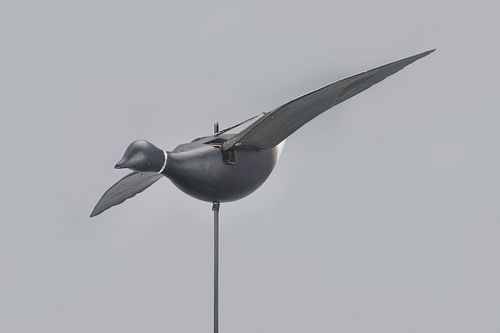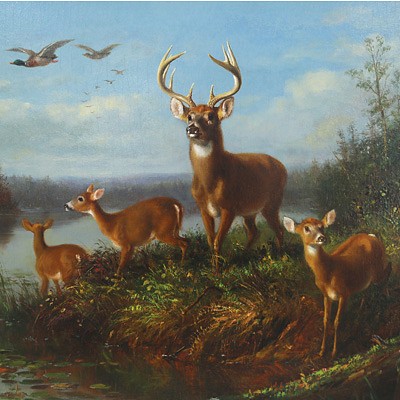Flying Brant Decoy by George William McLellan (1897-1987)
Lot 93
About Seller
Copley Fine Art Auctions
20 Winter Street
Pembroke, MA 02359
United States
Founded in 2005, Copley Fine Art Auctions is a boutique auction house specializing in antique decoys and American, sporting, and wildlife paintings. Over the course of the last two decades, the firm has set auction records for not only individual decoy makers, but also entire carving regions. Copley...Read more
Estimate:
$35,000 - $55,000
Absentee vs Live bid
Two ways to bid:
- Leave a max absentee bid and the platform will bid on your behalf up to your maximum bid during the live auction.
- Bid live during the auction and your bids will be submitted real-time to the auctioneer.
Bid Increments
| Price | Bid Increment |
|---|---|
| $0 | $50 |
| $1,000 | $100 |
| $2,500 | $250 |
| $5,000 | $500 |
| $10,000 | $1,000 |
| $25,000 | $2,500 |
| $50,000 | $5,000 |
About Auction
By Copley Fine Art Auctions
Feb 24, 2023
Set Reminder
2023-02-24 10:00:00
2023-02-24 10:00:00
America/New_York
Bidsquare
Bidsquare : The Winter Sale 2023, Day 1
https://www.bidsquare.com/auctions/copley/the-winter-sale-2023-day-1-11939
Lots 1-337 Copley Fine Art Auctions cinnie@copleyart.com
Lots 1-337 Copley Fine Art Auctions cinnie@copleyart.com
- Lot Description
Flying Brant
George William McLellan (1897-1987)
Eureka, CA, c. 1941
24 in. long, 41 in. wingspan
One of only nine flying decoys originally created for this legendary rig. Few would argue that Bill McLellan's famous rig of brant are the finest flyer decoys ever created. This rig was meticulously constructed in 1941 with the assistance of his wife, Olga (1902-1980). McLellan only used the carefully protected patterns about a dozen times over the next twenty years. Since then these peerless birds have been highly celebrated and prized by collectors, authors, and curators from coast to coast.
In 1989 Richard Wheeler wrote a feature article for "Decoy Magazine" entitled "Bill McLellan's wonderful flying brant,"discussing not only the rig, but his and Dorothy's experiences with McLellan a half a century ago and how they obtained this intricately swirl-painted decoy number "8." When the Wheelers arrived, the carver still had eight of the original nine, though one had "ruined body paint"from a friend's attempt to mold it, bringing the rig to only seven fine examples in original paint. While Wheeler was not able to acquire this flyer on that occasion, he was highly motivated and soon made arrangements to obtain "number 8."
The same year Wheeler published his story, West Coast decoy authorities, Michael Miller and Frederick Hanson illustrated this exact decoy, describing these famous flyers as "masterpieces of precision"in their book "Wildfowl Decoys of the Pacific Coast: Carving Traditions of British Columbia, Washington, Oregon and California."McLellan, even during his lifetime, recognized the important value of these decoys "for he made a special box for them that contained separate compartments for wings, pins, dowel, bodies, etc."The authors continue, "The redwood bodies, measuring about 24 inches in length, were fashioned from old telephone poles found in the alley behind his home. Bill created nicely detailed patterns to trace the top and side views on the redwood blocks before he started carving. Unlike the floaters, Bill did not equip these flyers with bills made of hardwood doweling. The wings were constructed in much the same manner as those on good model airplanes. McLellan used fine spruce for the frames, after first designing and preparing explicit patterns. When the frames were completed, stiff butcher paper was laid on followed by muslin. The fabric was then coated with airplane dope. The wing patterns were taken from the tracing of an actual brant wing- 'a big fella' according to McLellan. Each of the nine flying brant was numbered on the body and matching wings. The latter fit into the bodies with intricate, brass wing-locking mechanisms that allow quick removal or attachment. The wing-lock is hinged to allow the wings, rigged with heavy rubber bands, to waver in the wind. A copper pin secures the wings to the hinges. The flyers were deployed by means of telescoping 2-piece galvanized steel poles. Each of the nine poles, with each decoy at a different height, was attached to a floating wooden frame that was pulled over the sand into the water as the tide rose and fell."
McLellan did not stop with the form and construction, as the paint is perhaps the finest seen on any Pacific brant. Both the top and bottom sides of the stretched canvas wings are finished with excellent feathering. This decoy is particularly notable within the rig for its strong swirl paint towards the tail.
The Wheelers also acquired McLellan's incredible patterns which further confirm that this is perhaps the most intricately made rig of decoys ever constructed. The bird's refinement and function would have made an unrivaled sight on the choppy waters of Humboldt Bay. Indeed, McLellan recounted that on multiple occasions this vexed other hunters. Today, thanks to the Wheelers and other specialists, we have a robust understanding of this extraordinary rig.
"Supplementing the many floating brant decoys, McLellan made nine extraordinary flying brant decoys that are brilliant innovative achievements in artistry, workmanship, and construction.- Michael Miller, "Wildfowl Decoys of California," 2015
"The McLellan flying brant fit the criterion of masterful decoys.- Gerald M. Rosenthal, "The Great Book of Waterfowl Decoys,"1990
Original paint with light gunning wear. Working touch-up to two small tears on top of right wing and one across the underside of the wing.
Provenance: George W. McLellan Rig
Richard and Dorothy Wheeler Collection, acquired from the maker, circa 1973
Literature: Richard Wheeler, "Bill McLellan's Wonderful Flying Brant"Decoy Magazine, Lewes, DE, March/April 1989, pp. 36-41, rigmates illustrated. Michael R. Miller and Frederick W. Hanson, "Wildfowl Decoys of the Pacific Coast: Carving Traditions of British Columbia, Washington, Oregon and California," Davis, CA, 1989, pp. 129-133, exact decoy illustrated multiple times. Joe Engers, ed., "The Great Book of Wildfowl Decoys," San Diego, CA, 1990, pp. 269-270, rigmate illustrated. Michael R. Miller, "Wildfowl Decoys of California,"Spokane, WA, 2015, back cover and pp. 58-65, rigmates illustrated. Loy S. Harrell Jr., "Decoys: North America's One Hundred Greatest," Iola, WI, 2000, pp. 148-9, rigmate illustrated. Linda and Gene Kangas, "Decoys," Paducah, KY, 1992, p. 125, pl. 191, related example illustrated. Robert Shaw, "Bird Decoys of North America," New York, NY, 2010, p. 270, rigmate illustrated. Gene and Linda Kangas, "Decoys: A North American Survey," Spanish Fork, UT, 1983, p. 275, top bird, rigmate illustrated.Please email condition report requests to colin@copleyart.com. Any condition statement given is a courtesy to customers, Copley will not be held responsible for any errors or omissions. The absence of a condition statement does not imply that the lot is in perfect condition.Condition
- Shipping Info
-
Shipping info
Copley does not offer in-house packing or shipping. For clients who require shipping, please complete the Shipping Release Form and return it with your payment. The form includes a list of shippers we frequently work with.
-
- Buyer's Premium



 EUR
EUR CAD
CAD AUD
AUD GBP
GBP MXN
MXN HKD
HKD CNY
CNY MYR
MYR SEK
SEK SGD
SGD CHF
CHF THB
THB















